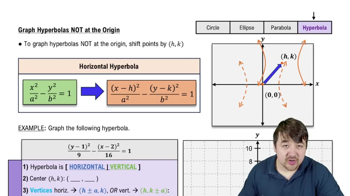Table of contents
- 0. Fundamental Concepts of Algebra3h 29m
- 1. Equations and Inequalities3h 27m
- 2. Graphs1h 43m
- 3. Functions & Graphs2h 17m
- 4. Polynomial Functions1h 54m
- 5. Rational Functions1h 23m
- 6. Exponential and Logarithmic Functions2h 28m
- 7. Measuring Angles40m
- 8. Trigonometric Functions on Right Triangles2h 5m
- 9. Unit Circle1h 19m
- 10. Graphing Trigonometric Functions1h 19m
- 11. Inverse Trigonometric Functions and Basic Trig Equations1h 41m
- 12. Trigonometric Identities 2h 34m
- 13. Non-Right Triangles1h 38m
- 14. Vectors2h 25m
- 15. Polar Equations2h 5m
- 16. Parametric Equations1h 6m
- 17. Graphing Complex Numbers1h 7m
- 18. Systems of Equations and Matrices3h 6m
- 19. Conic Sections2h 36m
- 20. Sequences, Series & Induction1h 15m
- 21. Combinatorics and Probability1h 45m
- 22. Limits & Continuity1h 49m
- 23. Intro to Derivatives & Area Under the Curve2h 9m
19. Conic Sections
Hyperbolas NOT at the Origin
Struggling with Precalculus?
Join thousands of students who trust us to help them ace their exams!Watch the first videoMultiple Choice
Describe the hyperbola 9(x+2)2−16(y−4)2=1.
A
This is a vertical hyperbola centered at (−2,4) with vertices at (4,2),(4,−6) and foci at (4,4),(4,−8).
B
This is a vertical hyperbola centered at (2,−4) with vertices at (4,1),(4,−5) and foci at (4,3),(4,−7).
C
This is a horizontal hyperbola centered at (−2,4) with vertices at (2,4),(−6,4) and foci at (4,4),(−8,4).
D
This is a horizontal hyperbola centered at (−2,4) with vertices at (1,4),(−5,4) and foci at (3,4),(−7,4).
 Verified step by step guidance
Verified step by step guidance1
Identify the standard form of a hyperbola equation: \( \frac{(x-h)^2}{a^2} - \frac{(y-k)^2}{b^2} = 1 \) for a horizontal hyperbola, and \( \frac{(y-k)^2}{a^2} - \frac{(x-h)^2}{b^2} = 1 \) for a vertical hyperbola.
Compare the given equation \( \frac{(x+2)^2}{9} - \frac{(y-4)^2}{16} = 1 \) with the standard form. Notice that the \( x \) term is positive and comes first, indicating a horizontal hyperbola.
Determine the center of the hyperbola from the equation \( (x+2)^2 \) and \( (y-4)^2 \). The center is \( (-2, 4) \).
Identify the vertices of the hyperbola. For a horizontal hyperbola, the vertices are \( (h \pm a, k) \). Here, \( a^2 = 9 \), so \( a = 3 \). The vertices are \( (-2+3, 4) \) and \( (-2-3, 4) \), which are \( (1, 4) \) and \( (-5, 4) \).
Calculate the foci of the hyperbola. The distance to the foci \( c \) is found using \( c^2 = a^2 + b^2 \). Here, \( b^2 = 16 \), so \( c^2 = 9 + 16 = 25 \), giving \( c = 5 \). The foci are \( (-2+5, 4) \) and \( (-2-5, 4) \), which are \( (3, 4) \) and \( (-7, 4) \).

 5:59m
5:59mWatch next
Master Graph Hyperbolas NOT at the Origin with a bite sized video explanation from Patrick
Start learningRelated Videos
Related Practice


